"...'It's not what you know, it's who you know.' ...a one-minute lecture to any young person who may read these words: Always try to associate yourself with and learn as much as you can from those who know more than you do, who do better than you, who see more clearly than you. Don't be afraid to reach upward." At Ease: Stories I Tell to Friends by Dwight D. Eisenhower. "Apart from the rewards of friendship, the association might pay off at some unforeseen time-that is only an accidental by-product. The important thing is that the learning will make you a better person."
The Eisenhower Life Series:
The Eisenhower Life Series is a curriculum series that traces the life and times of Dwight D. Eisenhower from 1890 until 1969. Each unit includes an engaging summary of an historical period, a fascinating review of Eisenhower’s life within the context of the times, and primary sources from the holdings of the Dwight D. Eisenhower Library. The series is published by The Eisenhower Foundation.
“Dreams of a Barefoot Boy: 1890—1911"
Poster
The story of the Dwight D. Eisenhower’s life begins in a small town in the heartland of nineteenth-century America. Here he matured into a bright, popular, handsome, and exceedingly ambitious young man.
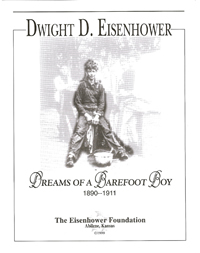 The influences that shaped his upbringing were common enough in Midwestern America one-hundred years ago: a profoundly religious family, the public school system, work and friendships, and the community of Abilene, Kansas, itself.
The influences that shaped his upbringing were common enough in Midwestern America one-hundred years ago: a profoundly religious family, the public school system, work and friendships, and the community of Abilene, Kansas, itself.
To truly know Dwight D. Eisenhower, it is necessary to go back and recreate, as best we can, his early years through his own words, primary sources, and the memories of those who knew him then.
“Dreams of a Barefoot Boy” is 46 pages long. It includes 22 primary sources, including documents, photographs and a 1901 plat map of Abilene, Kansas. A document analysis worksheet and 16 suggestions for learning activities complete the unit.
“Dreams of a Barefoot Boy” comes from General Eisenhower’s Homecoming Speech, delivered on June 22, 1945, in Abilene KS.
"Duty, Honor, Country: 1911-1935"
Poster
These years of Eisenhower’s life are less well known, but every bit as fascinating. They laid a solid foundation for his leadership in World War II and the presidency.
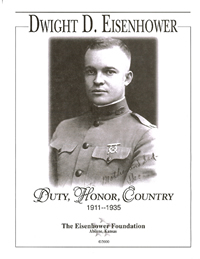 During this period, Eisenhower sometimes agonized that his career was gong nowhere, but research reveals a much different picture. From 1915 to 1935, he was propelled steadily upward through a combination of factors: his intense ambition, his considerable abilities, his perseverance, and the friendship of a very special mentor, General Fox Conner.
During this period, Eisenhower sometimes agonized that his career was gong nowhere, but research reveals a much different picture. From 1915 to 1935, he was propelled steadily upward through a combination of factors: his intense ambition, his considerable abilities, his perseverance, and the friendship of a very special mentor, General Fox Conner.
We see him tested, tempered, and strengthened by what he perceives as career shortcomings and disappointments. But nothing matches the nearly unbearable grief he endures at the tragic death of his and Mamie’s three-year-old son Doud Dwight.
“Duty, Honor, Country” is 53 pages long. It includes a poster, 21 primary sources, including documents and photographs. A chronology of Eisenhower’s early military years, four worksheets, and 14 suggestions for learning activities complete the unit.
“Duty, Honor, Country” is the motto of the U.S. Military Academy at West Point. Eisenhower adopted it as a guiding principle for the rest of his life.
"In the High Cause of Human Freedom: 1935-1945"
Poster
In 1935, Major Dwight D. Eisenhower was an anonymous man. In less than a decade, he would become a five-star general, an admired and celebrated world figure, and much loved hero.
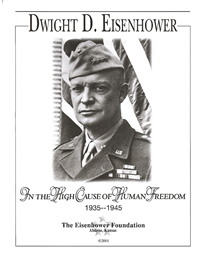 A look back to the eve of World War II reveals a striking portrait of a man poised to assume the reins of leadership. Had there been no war, history would have little mention of a very capable and good man named Dwight D. Eisenhower. But the war did come, and Eisenhower’s shooting star was no fluke of history.
A look back to the eve of World War II reveals a striking portrait of a man poised to assume the reins of leadership. Had there been no war, history would have little mention of a very capable and good man named Dwight D. Eisenhower. But the war did come, and Eisenhower’s shooting star was no fluke of history.
In the darkest days of World War II—when there was no glory, when the workload was punishing, when fatigue, worry, and illness threatened his health—he bore it and, even more, he transcended it. By the end of the war, Eisenhower had become the very personification of the righteous crusade that had prevailed over the dark forces of evil.
“In the High Cause of Human Freedom” is 60 pages long. It includes a poster, 22 primary sources, including documents and photographs. A chronology of Eisenhower’s war years, an official map of the Normandy Invasion, two worksheets, and 13 suggestions for learning activities complete the unit.
“In the High Cause of Human Freedom” comes from a 1945 speech by General Eisenhower.
"Called to a Higher Duty: 1945-1961"
Poster
Immediately following World War II, Dwight D. Eisenhower was U.S. Army Chief of Staff, President of Columbia University, and Commander of NATO. As escalating tensions of the Cold War polarized East and West, Americans, and many around the world, looked to Eisenhower for leadership and reassurance.
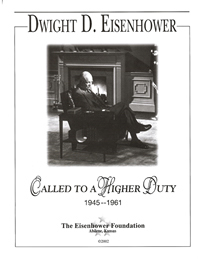
He managed to squelch an “Eisenhower for President” movement in 1948. But, by 1951, the course of world events and the incessant, impassioned appeals for him to consider a presidential run forced him to reconsider.
From 1953—1961, President Eisenhower led the nation through the perilous early years of the Cold War. He insisted that the security and prosperity of the United States rested on an engaged citizenry, a vital and expanding economy, responsible government spending, and military superiority. To that end, he worked tirelessly and selflessly—and often thanklessly—to serve the best interests of the American people.
“Called to a Higher Duty” is 67 pages long. It includes a poster, 20 primary sources, a document analysis worksheet, and 13 suggestions for learning activities.
“Called to a Higher Duty” comes from a 1952 letter written by General Eisenhower.
"All the Daydreams of My Youth Fulfilled: 1961-1969"
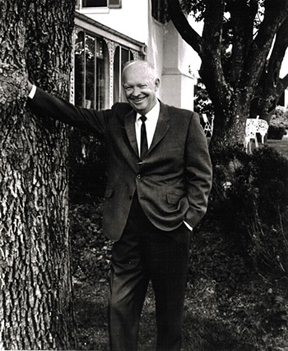
General Eisenhower, relaxing at his Gettysburg farm, during his retirement years: 1961-1969.
Part V of the Eisenhower Life Series is not yet available. Please continue to check back.
The manuscript collections and audiovisual archives contain many documents and photographs which may be useful to students working on historical papers, exhibit projects, media or dramatic performances. A good place to determine topics and resources available is the Library's Digital Documents section.
More information regarding the life and times of Dwight D. Eisenhower may be found through out the Eisenhower Center web site. Use the following search engine to locate information or photographs on specific events or topics. Use these searches to find information on any of the Presidential Libraries web site. Check the box next to the library or libraries you wish to search.
Enter search terms to narrow your search.